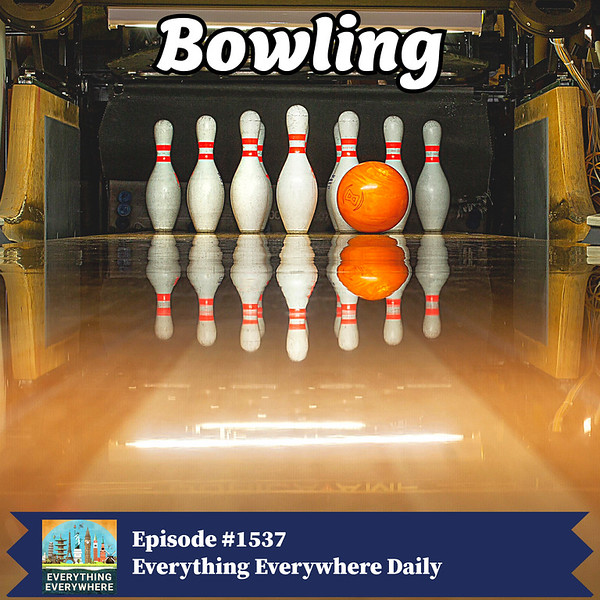Subscribe
Apple | Spotify | Amazon | iHeart Radio | Player.FM | TuneIn
Castbox | Podurama | Podcast Republic | RSS | Patreon
Podcast Transcript
A popular activity that millions of people around the world engage in every week is bowling.
Today, all the equipment manufacturers and bowling alleys constitute a multibillion-dollar business.
However, this modern pastime has a history that goes back not hundreds of years but thousands.
Learn more about bowling, where it came from and how it has developed on this episode of Everything Everywhere Daily.
If you have been listening to this podcast long enough, you probably have noticed a theme.
Many of the things in our modern world actually have ancient roots. So, too is the case with bowling.
Bowling is pretty simple when you break it down into its component parts. You roll a ball and knock down some pins. So, it should come as no surprise that the origins of what we call bowling can be found in ancient history.
The earliest evidence of something that we could identify as a proto-bowling was found in the grave of an Egyptian child in 1895. An archeologist and Egyptologist by the name of Sir Flinders Petrie, conducting a dig near the city of Naqada, Egypt, found items that resembled early bowling equipment.
He found a ball, nine pin-like objects, and a trilithon, which is an object that looks like an object from Stonehenge.
The objects were dated to 3200 BC, or about 5200 years ago.
The ball and pins were more closely related to the game of Skittles, which is played in the UK and Ireland.
Polynesians had a game known as Ulu maika. It involved rolling a disk made out of volcanic rock, but the objective was distance, not knocking over pins.
One of the earliest records of a game that bore a closer resemblance to modern bowling comes from ancient Germany around 300. A religious ceremony involved rolling a stone or wooden ball to knock down a “kegel,” a pin that symbolized sin. Successfully knocking down the kegel meant that the bowler was free of sin.
Bowling-type games were outdoor activities, and eventually, special greens were set up for bowling matches. These bowling games were closer to what we would know as lawn bowling or “bowls” in England. The object was reaching some target on the ground, not necessarily pins.
The oldest surviving bowling green is in Southampton, England. It was built in 1299 and is still in use today.
By the 14th century, bowling was quite popular in England. King Edward III allegedly banned it for soldiers in 1366 because it was distracting them from their archery practice.
In continental Europe, especially in Germany, Austria, and Switzerland, bowling was often played indoors with wooden floors and pins. It became popular as a common pastime for people of all classes.
Beginning in the 16th century and the Renaissance, bowling began to take a more recognizable shape to the modern game.
Henry VIII was said to be an avid bowler, and variations such as “ninepins” and “skittles” emerged. Ninepins became especially popular in taverns.
In Germany, covered facilities that allowed for playing in all conditions were built, called kegelbahns. These were usually attached to taverns.
Martin Luther was an avid bowler and had a bowling lane built near his home for his family. He supposedly established the number of pins used at nine. Previously in Germany, the number of pins could be between three and seventeen.
Dutch settlers brought their version of bowling, known as kegelen, to North America in the 17th century. This version was played in the settlement of New Amsterdam. It used nine pins set in a diamond shape.
By the 19th century, bowling had evolved in several American cities, particularly among German and Dutch immigrant communities. Ninepins became extremely popular, though it gained a bad reputation due to its association with gambling and crime.
The writer Washington Irving first explicitly mentioned nine-pin bowling in his 1819 book Rip Van Winkle.
In 1841, ninepins was banned in several places, leading to a new variation of the game that used ten pins instead. This change not only circumvented the ban but also laid the foundation for modern ten-pin bowling. Ten-pin bowling is the most common form of bowling today.
The American Bowling Congress (ABC) was founded in 1895 in New York City. This organization helped standardize the rules and fostered a more organized sport. They replaced the National Bowling Association established 20 years earlier, which had created standardized rules regarding ball and lane size.
The ABC established the modern scoring system for bowling, which was a maximum of 300 points over 12 possible balls, in addition to setting standards for balls and pins.
Bowling alleys began to appear, often as part of larger entertainment venues.
Other variants of bowling evolved in the Eastern United States around this time in the late 19th century. We’ll discuss those in a bit.
Bowling balls were initially made out of wood, often a hardwood called Lignum vitae from the Caribbean. However, in 1905, the Brunswick corporation introduced the “Mineralite” rubber ball, which replaced most wooden balls.
One of the biggest technical developments in bowling took place in 1952 when the American Machine and Foundry Corporation (AMF) introduced the automatic pinsetter. This mechanization revolutionized the sport, making bowling more accessible and allowing alleys to run more efficiently. Prior to this, pins for each bowling alley had to be set by hand. Bowling alleys literally had people on staff known as pinsetters, or the pins were connected to strings.
There have been organized bowling competitions since the establishment of the ABC. However, they only ran tournaments for men. In 1916, the Women’s International Bowling Congress was created. The two organizations merged to form the United States Bowling Congress.
Automatic pinsetters made bowling explode in popularity in the 1950s.
One of the reasons for bowling’s mass appeal was due totelevision broadcasts, with shows like “Championship Bowling” in the 1950s and 1960s.
Professional bowlers became household names, and leagues flourished.
This led to the establishment of the Professional Bowlers Association (PBA) in 1958 by Eddie Elias. It provided a platform for bowlers to compete professionally, and the sport’s popularity soared throughout the 1960s and 1970s.
The PBA created several celebrity bowlers, such as Earl Anthony, Pete Weber, Walter Ray Williams Jr., and Mark Roth.
Bowing leagues became popular, with millions of people participating in competitive amature leagues every week.
The number of leagues and bowlers began to decline in the 1980s and 1990s. This was due to changes in entertainment preferences and the rise of alternative sports and leisure activities.
To attract younger audiences, many bowling alleys introduced things like “cosmic bowling” with glow-in-the-dark lanes, music, and party atmospheres. This evolution helped keep bowling relevant as a social activity rather than just a competitive sport.
In 1998 there were 5,400 bowling centers in the United States. As of 2022, there were only 2,849. While the number has been steadily falling, it appears to have leveled off since the end of the pandemic with the number slightly growing a bit.
Before I mentioned that, there were several other variants of bowling that were created in the late 19th and early 20th centuries. Several of those still exist, albeit only in certain regions.
One of the most popular variants in Europe is nine-pin bowling. Nine-pin bowling goes back to the original 19th-century game, where players aim to knock down nine pins arranged in a diamond shape, as opposed to the ten-pin triangle arrangement used in modern bowling.
Each player rolls a wooden or composite ball without finger holes toward the pins, and the objective is to knock down as many as possible.
In parts of New England and the Atlantic Provinces of Canada, you can still find candlepin bowling.
Candlepin bowling is a variation of bowling that originated in New England and is characterized by its unique pins and smaller balls. The pins, which are tall and narrow with cylindrical shapes resembling candles, are harder to knock down than the wider pins used in ten-pin bowling. The ball used in candlepin is much smaller and lacks finger holes, weighing around 2-4 pounds. Players are allowed three rolls per frame, unlike the standard two in ten-pin, and the pins are not cleared between rolls, adding a strategic element to play.
Duckpin bowling is a variation of traditional bowling found in some Mid-Atlantic states, played with shorter and stouter pins than ten-pin bowling pins, making them resemble ducks, which is where the game gets its name. Despite their smaller size, duckpins are harder to knock down due to their shape and weight. The ball and rules are similar to that of Candlepin bowling.
Five-pin bowling is a Canadian variation of bowling that uses five pins arranged in a V-shape and a smaller ball that fits comfortably in the hand without finger holes. Each pin is worth a different point value: the center pin is worth five points, the next two are worth three points each, and the outer two are worth two points each, for a total of 15 points per frame.
I want to conclude this episode by moving from talking about bowling as an activity to discussing some of the rarest events in tenpin bowling.
The first is the difficulty of certain splits. In each bowling frame, you have two opportunities to knock down pins. If you knock down all the pins on the first try, it’s a strike. It is a spare if you know them all down in two tries.
However, what pins are remaining to get a spare can be easy or extremely difficult.
One of the most difficult spares is known as a 7-10 split. It is the two farthest pins in each corner. An average bowler will find this almost impossible to complete. However, a professional bowler will compete it 0.7% of the time.
However, this is not the most difficult split to pick up. That would be the 4-6-7-9-10 split, also known as the Greek Church. This is only picked up 0.2% of the time by professional bowlers.
One of the most difficult things to do is bowl a perfect game. A perfect game is scoring 300 points on 12 consecutive strikes. For an amateur player, a perfect game is rare enough that it might sometimes be published in a local newspaper.
Perfect games used to be extremely rare. However, the rate and number of perfect games have steadily increased since 1980. In 2010, over 50,000 perfect games were sanctioned.
The bowler with the most sanctioned perfect games is Fero Williams, who has reportedly rolled 135 perfect games.
The reason for the explosion in perfect games is primarily due to technology.
Modern bowling balls are designed with highly reactive materials, like urethane and resin, that give players better grip and control over the ball’s spin. This improved ball technology makes it easier to generate powerful hook shots that increase the likelihood of strikes.
The oil patterns on lanes have become more standardized, and bowlers now have better knowledge of how oil patterns affect ball movement. Many bowling alleys use oil patterns designed to guide the ball toward the pocket, making strikes more frequent.
Rolling a perfect game is impressive. However, bowling contests are usually conducted in a series of three games. What is truly the rarest feat of all is bowling a perfect 900 series, three consecutive perfect games in a row.
The first 900 series took place on July 1, 1982, by Glenn Allison, a former PBA competitor, at the La Habra Bowl in La Habra, California. Even though it was in sanctioned league play, the American Bowling Congress refused to recognize the achievement.
Today, a small and very vocal group seeks to get his 900 series approved.
In fact, the ABC refused to recognize the first 6 900 series ever rolled.
The first 900 series was officially recognized was rolled by Jeremy Sonnenfeld in 1997 at Sun Valley Lanes in Lincoln, Nebraska. He was a member of the highly successful University of Nebraska bowling team.
As the number of 300 games has increased, so has the number of 900 series. Since Sonnefeld’s first recognized perfect series in 1997, there have been a total of 39 recognized perfect series.
Perhaps the most controversial series is the two 900 series by Robert Mushtare. He supposedly rolled his two 900 series in 2005 and 2006 when he was 17 and 18. In addition to these, he claimed to have done it another time as well.
The reason for the controversy is that he claims to have done it in a prebowling session for a league, where he bowled alone with no witnesses.
Bowling has come a long way from its ancient origins as a children’s game in Egypt and its use to remit sins in medieval Germany.
Despite having decreased in popularity over the last several decades, it is still a multibillion-dollar industry that is enjoyed by millions.



